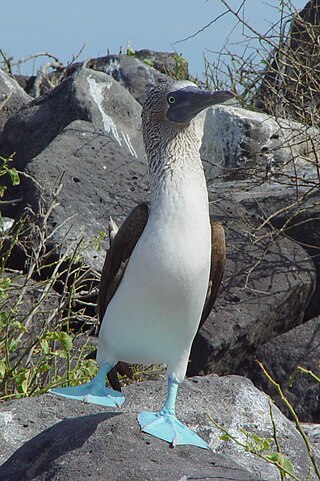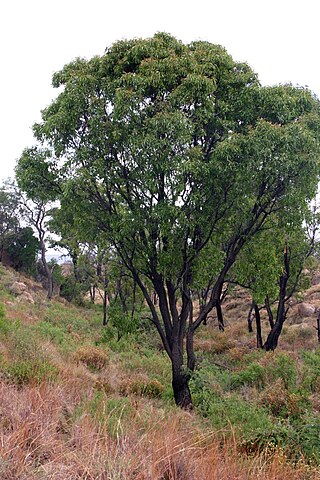
Mackerel is a common name applied to a number of different species of pelagic fish, mostly from the family Scombridae. They are found in both temperate and tropical seas, mostly living along the coast or offshore in the oceanic environment.

The International Union for Conservation of Nature (IUCN) is an international organization working in the field of nature conservation and sustainable use of natural resources. Founded in 1948, IUCN has become the global authority on the status of the natural world and the measures needed to safeguard it. It is involved in data gathering and analysis, research, field projects, advocacy, and education. IUCN's mission is to "influence, encourage and assist societies throughout the world to conserve nature and to ensure that any use of natural resources is equitable and ecologically sustainable".

The International Union for Conservation of Nature (IUCN) Red List of Threatened Species, also known as the IUCN Red List or Red Data Book, founded in 1964, is an inventory of the global conservation status and extinction risk of biological species. A series of Regional Red Lists, which assess the risk of extinction to species within a political management unit, are also produced by countries and organizations.

A booby is a seabird in the genus Sula, part of the family Sulidae. Boobies are closely related to the gannets (Morus), which were formerly included in Sula.

The macaques constitute a genus (Macaca) of gregarious Old World monkeys of the subfamily Cercopithecinae. The 23 species of macaques inhabit ranges throughout Asia, North Africa, and Europe. Macaques are principally frugivorous, although their diet also includes seeds, leaves, flowers, and tree bark. Some species such as the long-tailed macaque will supplement their diets with small amounts of meat from shellfish, insects, and small mammals. On average, a southern pig-tailed macaque in Malaysia eats about 70 large rats each year. All macaque social groups are arranged around dominant matriarchs.

The Madagascar ericoid thickets is a montane shrubland ecoregion, found at higher altitudes on Madagascar's four major mountains.

An IUCN Red List Critically Endangered species is one that has been categorized by the International Union for Conservation of Nature as facing an extremely high risk of extinction in the wild. As of 2021, of the 120,372 species currently tracked by the IUCN, there are 8,404 species that are considered to be Critically Endangered.

The dapple-throat is a species of bird in the small African family Modulatricidae. Other common names include dappled mountain robin and dappled mountain greenbul. It is native to Mozambique and Tanzania. This is the only species in the monotypic genus Arcanator.

Beauprea is a genus of flowering plants in the family Proteaceae. Its 13 extant species are endemic to New Caledonia, though closely related forms have been found in the fossil records of Australia and New Zealand. Its closest extant relatives are the African Protea and Faurea.

Faurea macnaughtonii is a species of tree in the family Proteaceae. It is found in South Africa and Eswatini, and was named in honour of Colin B. MacNaughton, Conservator of Forests at Knysna during the 1890s.

Faurea is a genus containing 16 species of flowering plants in the protea family which occur in the summer rainfall area of southern Africa, extending to tropical Africa and Madagascar. The name honours South African soldier and botanist William Caldwell Faure (1822-1844) who was killed on active service in India.

Faurea saligna is a graceful, semi-deciduous tree of the family Proteaceae growing to about 10 metres, or up to 20 metres under forest conditions. Found from tropical Africa south to the Transvaal, Swaziland and Natal, often in large communities on sandy soil and along stream beds.
As of July 2016, the International Union for Conservation of Nature (IUCN) lists 238 conservation dependent species. 0.29% of all evaluated species are listed as conservation dependent. The IUCN also lists seven subspecies and five varieties as conservation dependent.

Faurea galpinii is a small tree that grows to 10 m (20 ft.) tall, but its trunks will vary depending on growing conditions. The leaves of F. galpinii are alternately lanceolate with wavy margins. When growing in the forest, the bark appears grey with smooth, concentric rings, although it can appear rough and dark under exposed conditions, and the variety Faurea gal pinii varies in size from 1 m to 2 m.

Faurea rochetiana, also known as the broad-leaved beechwood, is a tree found in much of Africa from Sudan south to Limpopo, Mpumalanga and northern KwaZulu-Natal. The tree is small and leafy. It has wider leaves, larger flowers and flower veins and also denser hairy twigs than the bushveld beechwood. The tree's national number is 76.
Faurea recondita, also known as the Kamdeboo beechwood, is a tree that forms part of the genus Faurea. It occurs in the Kamdeboo Mountains. The species was only identified in 2013 after it was discovered in 2008. The tree grows on average two metres high. It has many similarities with Faurea coriacea found in Madagascar.
Faurea racemosa is a tree that forms part of the Faurea genus and is native to Malawi and Mozambique.
Faurea coriacea is a tree that forms part of Faurea genus.














